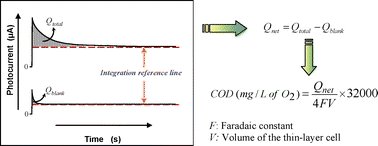A new approach prevailing over chloride interference in the photoelectrochemical determination of chemical oxygen demand
Abstract
A new approach to overcome chloride interferences in the photoelectrochemical determination of chemical oxygen demand (PeCOD™) was developed. This approach was based on the kinetic characteristics of photocatalytic oxidation reactions of chloride in the presence and absence of organics. The effectiveness of the proposed approach was evaluated using the newly developed PeCOD™ system with a wide range of possible scenarios. It was found that the chloride interference was insignificant when a sample meets the two critical criteria, i.e., chloride concentration ≤26.6 ppm and the concentration ratio of chloride to organics ≤5 : 1 (ppm Cl−/ppm COD). The Chemical Oxygen Demand (COD) of such a sample can be directly determined by the direct PeCOD™ method. When the chloride content in a sample exceeds 26.6 ppm, an appropriate sample dilution could effectively reduce the chloride interference to less than 5%, if the diluted sample meets the critical criteria. An organic addition method was proposed to deal with scenarios for samples containing high chloride and low organic concentrations where the critical criteria cannot be met by simple dilution. Such an approach greatly extends the applicability of the proposed method, covering a wide range of possible real-world scenarios without the need to use expensive (i.e. AgNO3) and toxic (i.e. HgSO4) masking reagents.


 Please wait while we load your content...
Please wait while we load your content...